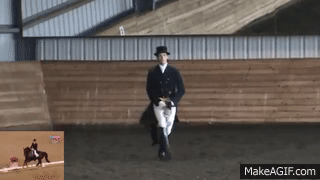All of us who ride and show reining horses — from the open champion to the rookie amateur — are ambassadors for the sport in our daily lives. While it’s always flattering to have your friends and coworkers take an interest in your passion, it’s also important to remember that a lot of reiner-ese will fly right over their heads: as much fun as you might have talking about the finer points of reining’s descent from the working cowboy’s toolbox out on the range, you also know that kind of history lesson tends to make people’s eyes glaze over.
We’ve taken the liberty and described each reining maneuver in “regular-people” language that anyone can understand around the water cooler.
Sliding stops
You might as well start your explanation here, because the walls of your office or cubicle are already plastered with photos of you and your horse sliding to perfection with dirt spraying everywhere so there’s an easy visual.
A sliding stop is like when a baseball player slides into base: it’s fun watching them slide easily home, the sliding fails not so much, but when it all comes together there is nothing better. You know: like when you were a kid and you used to slide around on the kitchen floor in your socks. It’s kind of like that, only on horseback.
Spins
The horse turns around with speed and accuracy on his haunches, while the rider tries hard not to fall off due to the centrifugal forces. No, the horses don’t get dizzy. Yes, the riders might.
Lead changes
(Forget actually explaining anything here: this is best demonstrated to your coworkers by skipping around the lunch room and then swapping your lead foot. Go on, cowboy up. The reining community is depending on you.)
Circles
Okay, look, if your friends can’t figure out what it means to ride in a circle with precision, don’t bother trying to explain anything else to them. Seriously.
The reining pattern as a whole
Think of it as kind of like your driver’s test when you got your license: they give you the course to drive and your job is to do it as smoothly and accurately as possible without breaking any road laws or running anyone over or making it look like you’re trying too hard. Remember that time you jerked on the steering wheel and destroyed that cone? Or slammed on the brakes so hard your driving teacher bounced off the dashboard? Yeah, the reining judges don’t like it when you do that either.
 Virtual Horse Help and Worldwide Slide Horse Training Videos, Show Coverage, Features, Behind-the-Scenes & Bi-Weekly E-Neewsletters
Virtual Horse Help and Worldwide Slide Horse Training Videos, Show Coverage, Features, Behind-the-Scenes & Bi-Weekly E-Neewsletters













